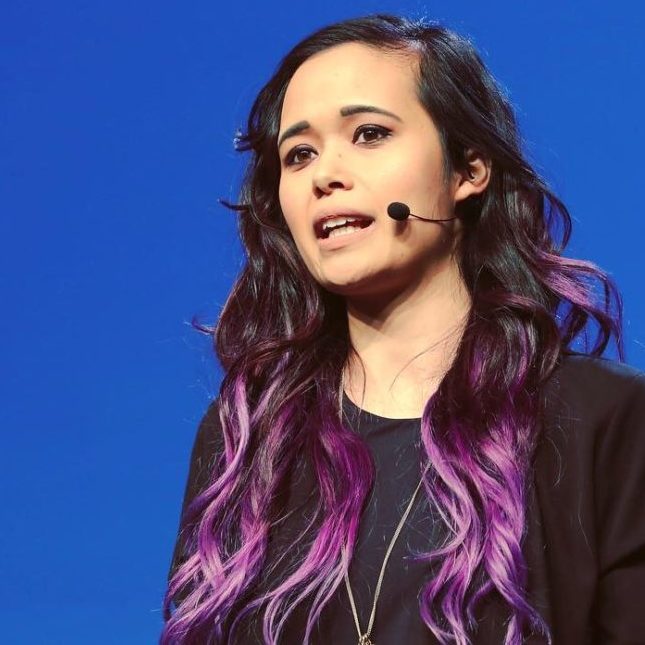As we gear up for 2025 SaaStr Annual on May 13-15 in SF Bay, I’ve found myself re-watching this great session with David Sacks from 2021 on the SaaS org chart. Some of it assumes a bit more aggressive spend than is practical for most today, but the overall lessons on who to hire, when; who to promote, and when; and how and why things get less efficient over time are just terrific
………
As your SaaS company grows and you go through various fundraising stages, your company size also grows. You’ll need to hire aggressively to get to the next level and continue that rapid growth. But what roles should you hire for, and what will your org chart look like at each stage?
David Sacks, Co-Founder and General Partner at Craft Ventures, shares wisdom from his years of experience in SaaS to help you build your org chart for each step of your company’s fundraising journey.
You can find the full slide deck from David’s presentation on Slideshare.
Want more? Enter your email below for the latest SaaStr updates
David Sacks: SaaS Background and Investments
David’s first foray into SaaS was in 1999 when he joined a startup that would become PayPal, starting as the product leader and later as the COO. In 2008, he founded Yammer, an enterprise software company that David grew to 500 employees and $60 million in sales. Microsoft acquired Yammer for $1.2 billion in 2012.
David Sacks has invested in over 20 unicorn companies, including Airbnb, Bird, ClickUp, Facebook, Slack, and Uber.
General Rules of Thumb For Company Size Based on ARR
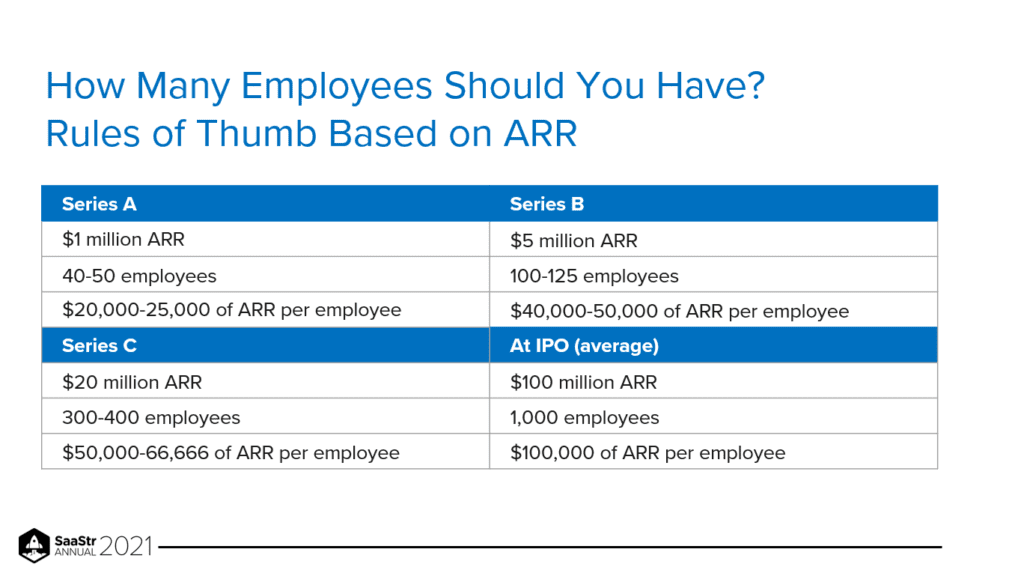
Your org will look different depending on each fundraising stage. Here are David’s recommendations for general rules of thumb to follow.
- Series A
- ARR: $1million
- Employee Count: 40 – 50
- ARR per Employee: $20,000 – $25,000
- Series B
- ARR: $5million
- Employee Count: 100 – 125
- ARR per Employee: $40,000 -$50,000
- Series C
- ARR: $20million
- Employee Count: 300 – 400
- ARR per Employee: $50,000 – $66,666
- At IPO (Average)
- ARR: $100million
- Employee Count: 1,000
- ARR per Employee: $100,000
These aren’t strict and rigid rules for everyone, as there will always be some variation depending on company type and other circumstances, but they are general guidelines to help indicate if you’re in the ballpark.
The Org Journey: Series A – Series C
Series A (~ 50 Employees)
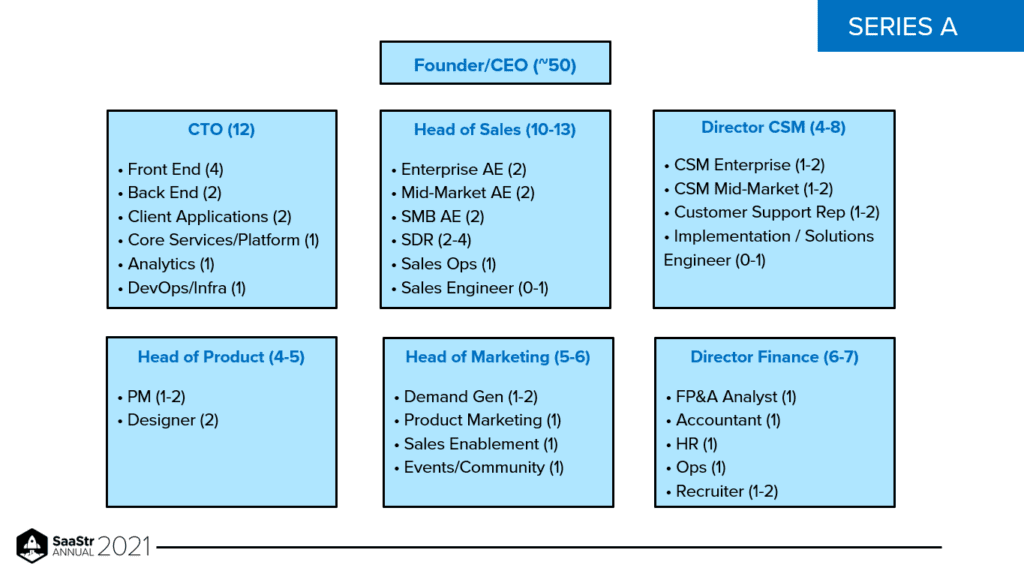
You will continue to expand and iterate based on this basic model as you grow:
Founder/CEO
- CTO
- Team Size: 12
- Positions Needed: Developers (Front-End and Back-End), Client Applications, Core Services/Platform, Analytics, and DevOps.
- Head of Product
- Team SIze: 4 -5
- Positions Needed: PMs and Designers.
- Head of Sales
- Team Size: 10 – 13
- Positions Needed: Enterprise AEs, Mid-Market & SMB AEs, SDRs, Sales Ops, Sales Engineer.
- Head of Marketing
- Team Size: 5 – 6
- Positions Needed: Demand Gen, Product Marketing, Sales Enablement, Events/Community.
- Director of CSM
- Team Size: 4 – 8
- Positions Needed: Enterprise CSM, Mid-Market & SMB CSM, Customer Support Reps, Implementation/Solutions Engineer.
- Director of Finance
- Team Size: 6 – 7
- Positions Needed: FP&A Analyst, Accountant, HR, Ops, Recruiter.
At this early stage, your teams are lean, made up mostly of individual contributors, with department heads reporting directly to the CEO. David considers product to be its own department that should also report directly to the CEO, instead of falling under the CTO. “Most SaaS founders these days are product founders, and I think it’s important for them to stay involved in the product. The way I always saw it was that the product managers were kind of like my hands when I was CEO…so I think it’s important for the product organization, even though it’s very small, to report directly to the Founder/CEO.”
Series B (~ 125 Employees)
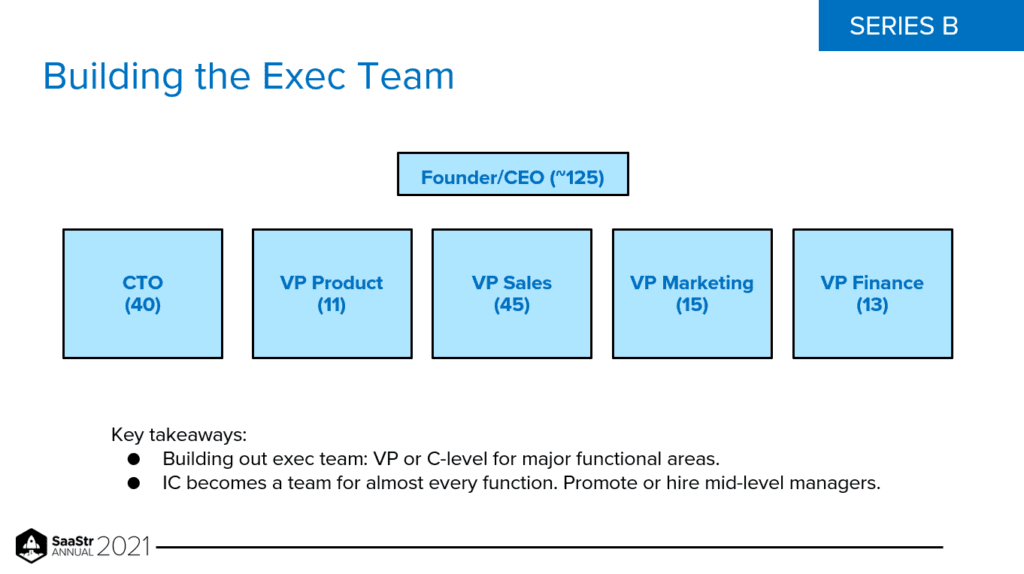
Here you will begin to build out your executive team. You will want to give more formal roles to your department heads as their responsibilities grow. As the CEO, you will fill VP and C-level positions with outside hires or promote from your current department leads.
During this stage, the individual contributors from Series A will grow to become a team for almost every function. You will need to promote and hire more mid-level managers.
Founder/CEO
- CTO (40 Employees)
- VP Product (11 Employees)
- VP Sales (45 Employees)
- VP Marketing (15 Employees)
- VP Finance (13 Employees)
Series C (~ 400 Employees)
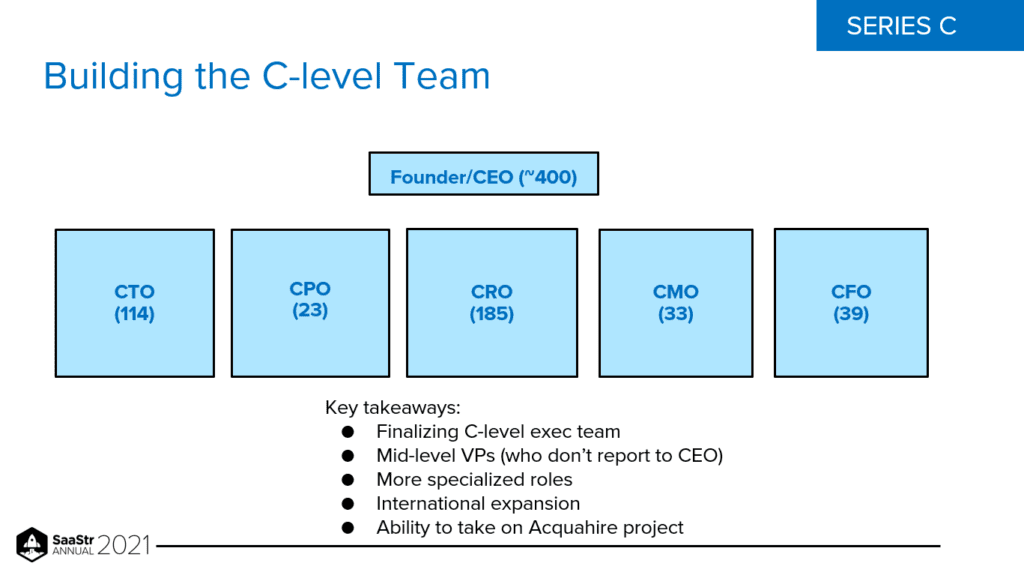
By the time you’ve reached Series C, your org will have evolved to look very different from Series A. You will be finalizing your C-level team and hiring the mid-level VPs who don’t report directly to the CEO.
You will probably discover the need for more highly specialized roles in your org. In addition, you will begin international expansion if applicable to your business. Finally, this is the point where you might consider acquiring companies as well.
Founder/CEO
- CTO (114 Employees)
- CPO (23 Employees)
- CRO (185 Employees)
- CMO (33 Employees)
- CFO (39 Employees)
Key Takeaways
When you start selecting department leaders in Series A, give yourself flexibility by keeping the title as something broad, like “Head of Sales,” for example. Save the VP, Director, and C-level titles for a little bit down the line –– you want to make sure the same people will still be with you in the future and that you can confidently promote them with their skill set for a more formal role.

